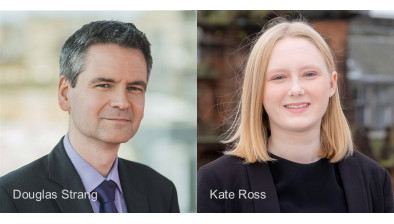Lucy Hunter Blackburn: Schools, associations and Section 35 – what the Scottish government left out of its argument

The week ahead sees the battle between the Scottish and UK governments over the Gender Recognition Reform (Scotland) Bill (GRR) move into court as Scottish ministers seek to overturn the Section 35 Order put in place by the Secretary of State for Scotland, currently blocking the bill from becoming an act. Dr Lucy Hunter Blackburn looks at the issues around schools and associations in the context of the Section 35 order and the case.
For the most part, arguments about the impact of reform have focused on the operation of single-sex services and spaces, and whether these will be affected by reform. Under the Equality Act 2010 service providers can choose to use ‘exceptions’ to exclude people of the opposite sex, however they identify. The argument here revolves around whether such policies are harder to apply to Gender Recognition Certificate (GRC) holders than to non-GRC holders, and how far extending GRCs to a much larger, more diverse group will make it harder in practice to exclude anyone from a woman-only space
There are other contexts, however, in which a GRC opens a door no-one can ever close, at least as the law currently stands. These have received less attention, but form part of the UK government’s justification for the Section 35 Order. They relate to clubs and associations, and schools.
Schedule 16 of the Equality Act allows associations to exist whose main purpose is to bring together people who share a particular protected characteristic. Under the Act, an Association is any group with 25 or more members, membership rules and a “genuine selection process” for members.
Such associations may be for any protected characteristic (except marriage and civil partnership). As EHRC guidance put it at the time the Act was passed: “It is lawful to have a private club for women, for people from Australia, for transsexual people or for people who are HIV positive.” The provision also covers single-sex youth organisations like the Girl Guides and the Boys’ Brigade.
Late last year, Lady Haldane ruled that acquiring a GRC changes a person’s sex for the purposes of the Equality Act. Next month the Scottish government will be back in court resisting an attempt by campaigners For Women Scotland to have that judgment overturned, in a separate case from the one related to Section 35.
As long as the judgment stands, any woman-only club or association must admit as a member any male person who has acquired a female GRC, providing other criteria for joining are met. Unlike a single-sex service, there is no exception they can reach for. GRC holders are currently very small in number, however, and joining that group involves some gate-keeping.
If in the upcoming Section 35 case the judge (Lady Haldane again) gives a green light for the GRR to proceed, and this withstands any appeal, the combined effect of the two judgments would be to open the doors of all women-only clubs and associations to any man willing to make a relatively quick, simple, and barely contestable act of self-declaration. And no-one will be able to say no.
In contrast to all other protected characteristics, in the case of sex the Scottish government is therefore seeking the power to make associations accept people who would otherwise, by definition, be excluded, on no more than its rubber-stamping of a person’s say-so.
Women who do not want to grant the state that power will have to give up organising in groups with a formal membership of more than 25.
A similar situation applies to schools. Again, there is no ‘exception’. Here the Scottish government’s plan to make GRCs available from aged 16 upwards will also bite. If Lady Haldane’s previous judgment stands, and the Bill is permitted to become an Act, then it will become legally impossible for anyone to operate a girls’ high school in Scotland that does not admit boys of 16 up, if they have a female GRC. In January this year, before the Section 35 Order was announced, the Scottish Council of Independent Schools stated that schools will ‘adapt practice accordingly in a way that best suits the pupils and matches regulatory requirements’.
The point here is not how many single-sex schools currently operate; but that such schools will in effect be permanently outlawed here, regardless of who wants to set one up in future, and however much demand there is.
This, and the adverse impact on single-sex associations, are among the reasons put forward, and discussed at some length, by the UK government for the Section 35 Order. The UK government has also noted that a UK-wide single-sex club or association could be required to have different membership in different parts of the UK.
The Scottish government meanwhile has briskly dismissed any attempt to draw out the full logic of embedding in law its preferred policy positions here as not being based on the ‘real world experience of comparable schemes’ and being ‘abstract and hypothetical’ and ‘too minor’ to justify the Order. Its submissions to the court do not acknowledge associations or schools as issues raised.
The substantive points the Scottish government engages with, and dismisses, are those relating to the potential for fraudulent applications and lack of safeguards. Safety (and privacy and dignity) are important reasons for allowing women space away from men. But not the only ones. Responding to an earlier consultation on the bill, the organisers of the Audacious Women Festival observed that women-only spaces “enable women to start to overcome some of the issues we face because of the constraints, expectations, socialisation and limitations imposed on us as a result of being brought up female. We know we need room to explore our own self-development and power away from the male gaze and unaffected by the pervasive sense of male-entitlement that is always a factor in mixed spaces”.
Not long ago, this would have been an unexceptional feminist rationale to offer for women-only groups.
Last year’s judgment crystallised that women and girls did not have a fully protected legal right to that experience, but in practice the effect was only at the margins. However, if it is combined with granting GRCs purely based on self-declaration, the ability of women and girls in Scotland to organise together in settings as various as walking groups, choirs, professional networks, youth movements and schools, away from all members of the opposite sex, will be more completely lost. It is hard to see that as progress.
Dr Lucy Hunter Blackburn is a member of MurrayBlackburnMackenzie. She was formerly a senior civil servant in the Scottish government.









